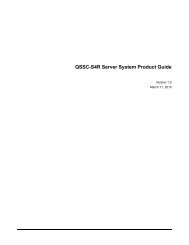Intel® Server System Server System "Emerald Ridge ... - CTL
Intel® Server System Server System "Emerald Ridge ... - CTL
Intel® Server System Server System "Emerald Ridge ... - CTL
You also want an ePaper? Increase the reach of your titles
YUMPU automatically turns print PDFs into web optimized ePapers that Google loves.
錯 誤 ! 尚 未 定 義 樣 式 。 EPSFunctional Specificationprograms one or more memory throttling temperature thresholds into the memory throttlingsubsystem during POST. These thresholds define the DIMM temperature value for whichdifferent levels of memory throttling take effect.The BMC uses one of these thresholds as the reference point to calculate the currenttemperature margin for an individual DIMM sensor. The DIMM with the most positive margin isconsidered the dominant margin of the group. This value becomes the current sensor readingfor the aggregate (IPMI) DIMM temperature sensorOnce the BMC has received notification that the DIMM temp sensor and memory throttlingconfiguration has completed, the BMC will enable any aggregate DIMM margin sensors definedfor the platform only if the throttling mode is CLTT (OLTT DIMMs are not supported) and thereare valid DIMM temp sensors present that are associated with the specific aggregate DIMMmargin sensor.If DIMMs with temperature sensors are present in the system and BMC monitoring of the DIMMtemperatures is enabled, then the BMC will periodically poll for these temperature readings in 3second of scan rate. These aggregate sensors are primarily used as input to the system fanmanagement control algorithms but may also be used for reporting temperature margininformation and SEL logging.This sensor is unavailable during a memory hot-plug or memory on-line/off-line operation that isperformed on a memory board associated with this sensor.These sensors are implemented as auto-rearm threshold margin sensors.3.17.1.2 DIMM Temperature Input to Fan Control AlgorithmThe BMC can use aggregate margin sensor as the input for a clamp algorithm that increasesfan speed if the margin exceeds a given clamp value. Each supported aggregate sensor may beused as a control input for one or more fan control domains. This configuration is specified usingTControl OEM SDRs.To support user choices regarding acoustic targets versus memory performance options, thefan control algorithm can utilize a different margin clamp value for each option. This isimplemented by using different Tcontrol SDRs for the Fan Profiles associated with each option.A negative aggregate margin sensor value means that all DIMMs are below their T1 values andno temperature-based memory throttling is in effect.If that sensor is linked to a Tcontrol Clamp sub-record with a negative clamp point, the BMCincreases fan speed before temperature-based throttling takes effect. This is associated with aperformance-optimized profile.If an aggregate margin sensor is linked to a Tcontrol Clamp sub-record with a positive clamppoint, temperature-based throttling takes effect before the BMC increases the fan speed. This isassociated with an aggressively acoustics-optimized profile. Acoustics-optimized profiles mayalso use negative clamp points and rely on more aggressive memory throttling (configured byBIOS) to reduce the overall cooling requirements.Revision 1.1Intel ® Confidential 35









